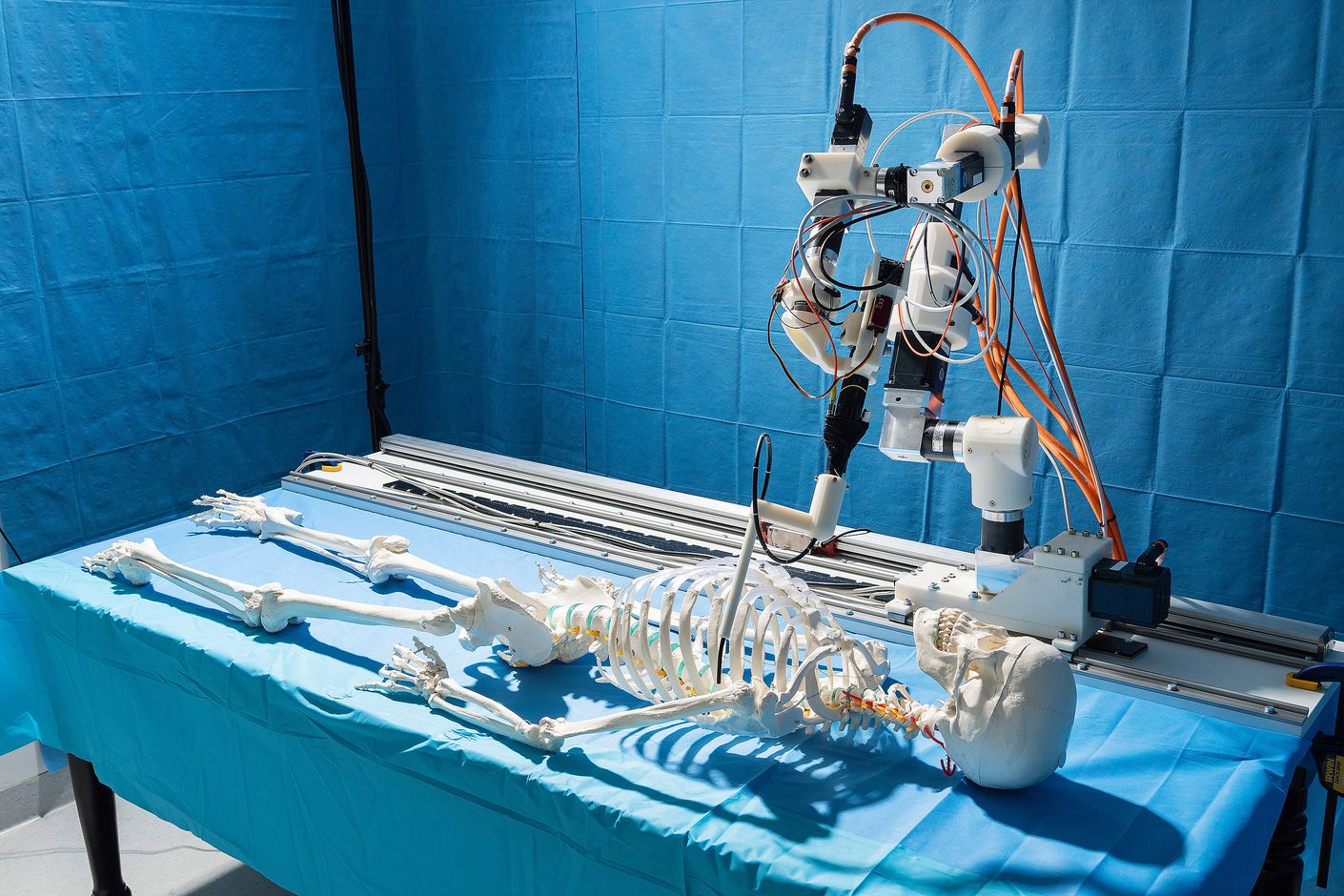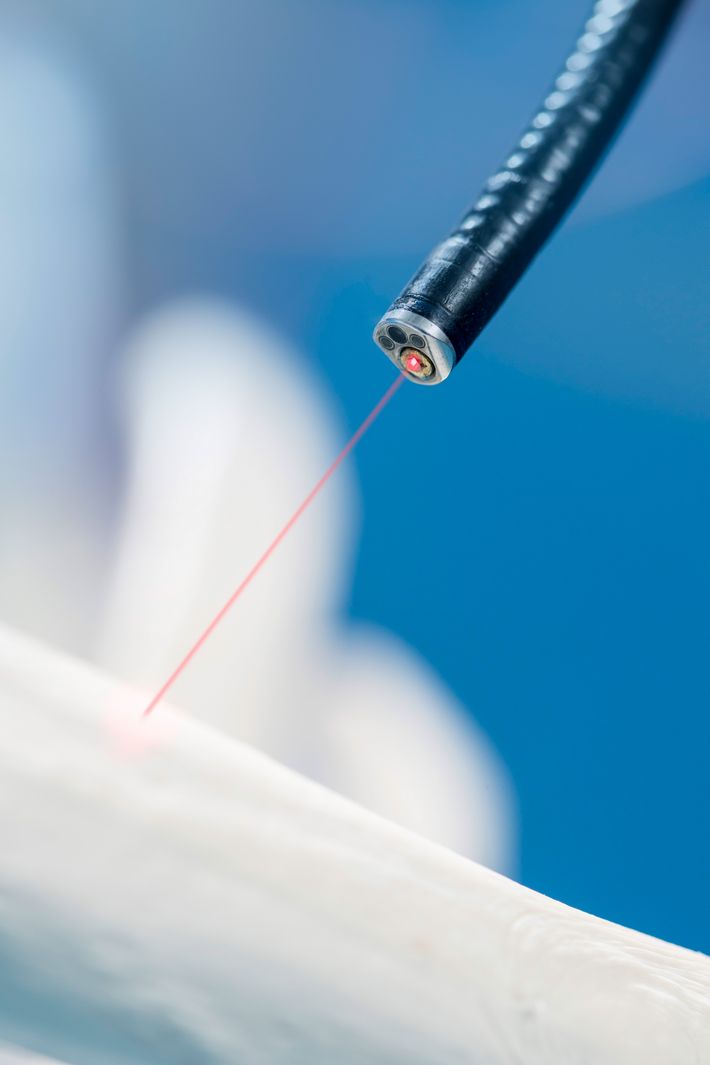
Bone surgery using laser technology
Researchers at the University of Basel are working towards making minimally invasive bone surgery reality—using robot-guided lasers, a technique that could greatly reduce patient recovery times and even be used to treat patients with overall poor health. The Werner Siemens Foundation has provided funding to the project MIRACLE since 2014.
Since the early days of laser research in the 1950s, surgeons have dreamt of using powerful, consolidated light beams to operate on bones. After numerous setbacks, researchers at the University of Basel believe they are now close to realising this dream, thanks to the new project MIRACLE—Minimally Invasive Robot-Assisted Computer-Guided LaserosteotomE. In the future, it's hoped that surgeons will be able to conduct minimally invasive operations using a robot-guided laser osteotome.
Greater precision
An osteotome is a surgical device used to cut through bone—for example, a chisel, a drill or a bone cutter. Operations using laser osteotomes promise numerous advantages, first and foremost: greater precision. Lasers can cut through bone with utmost accuracy and achieve highly complex incisions. As a result, bones knit more quickly after an operation and require less complex fixation techniques. In addition, laser surgery guards against heating and damaging the surrounding tissues—a common side-effect when using a bone cutter. A further advantage is that large incisions in the skin will no longer be necessary to operate on bones. Surgery using a laser osteotome will require only a small hole through which the endoscope is inserted.
Faster recovery times
This less invasive procedure leads to shorter hospitalisations and more rapid recovery times. As such, it’s also suitable for patients with overall poor health. This is all the more important as the increase in general life expectancy will be accompanied by an increase in wear and tear on bones and joints.

Robots with 3D navigation technology
Innovative laser osteotomy can be used in various scenarios, for example, in knee and back surgery, and to remove tumours from bone tissue. Ideally, the technique will also be used to transplant bone and cartilage. The Werner Siemens-Foundation is proud to support the MIRACLE project, which pursues four main goals: channelling laser technology for application in bone surgery; developing a robot for minimally invasive interventions; designing innovative technologies for 3D navigation to guide the robot in high-precision operations; and developing tailor-made bone implants using a 3D printer.
Interdisciplinary lighthouse project
MIRACLE is a lighthouse project of the Department of Biomedical Engineering at the University of Basel. It's located at the Switzerland Innovation Park Basel Area, in Allschwil, near Basel. The interdisciplinary team combines the expertise of some 30 researchers from the fields of medicine and the natural sciences.
The project is led by Philippe Cattin, professor of medical image analysis, and Hans-Florian Zeilhofer, head of the Clinic of Oral and Maxillofacial Surgery at the University Hospital Basel. Phillipe Cattin’s research group has extensive experience in medical image processing: Cattin was head of a project exploring robot-based laser osteotomy in the National Centre of Competence in Research “Computer Aided and Image Guided Medical Interventions” of the Swiss National Science Foundation. Hans-Florian Zeilhofer is specialised in 3D planning of complex surgical interventions and has been at the forefront of research on laser osteotomy for the past 15 years. Together, Cattin and Zeilhofer designed an initial laser osteotomy system to perform operations via an open skin incision. Now, researchers can build on this experience to develop a completely novel, minimally invasive technology.
Augmented Reality
Funding from the Werner Siemens-Foundation has enabled two assistant professorships to be added to the MIRACLE team: Azhar Zam is head of the group Medical Laser Physics and Optics, and Georg Rauter is head of the group Medical Robotics and Mechatronics. In June of 2017, the researchers were able to present GG1, an initial prototype for a laser robot. The group has also made advances with innovative implants and in 3D navigation; the 3D visualisations of the body (virtual reality) created using their new software SpectoVive can be used to expedite operation planning—and to better anticipate the actual conditions. Moreover, surgeons can use augmented reality technology (via special glasses) to move virtually through a patient’s body, thus ensuring greater precision. The value of the advances made by the researchers in Basel is, however, not limited to just laser osteotomy: these techniques are applicable in a variety of surgical procedures—which is why it comes as no surprise that the MIRACLE project has already generated three spinoff companies in the past two years.
The schedule is ambitious: by 2021, the team aims to have tested bone operations using robot-guided lasers technology on animal cadavers and human bodies donated for research. By 2025, laser osteotomy should be ready for clinical application.
Text: Adrian Ritter
Photos: Frank Brüderli



